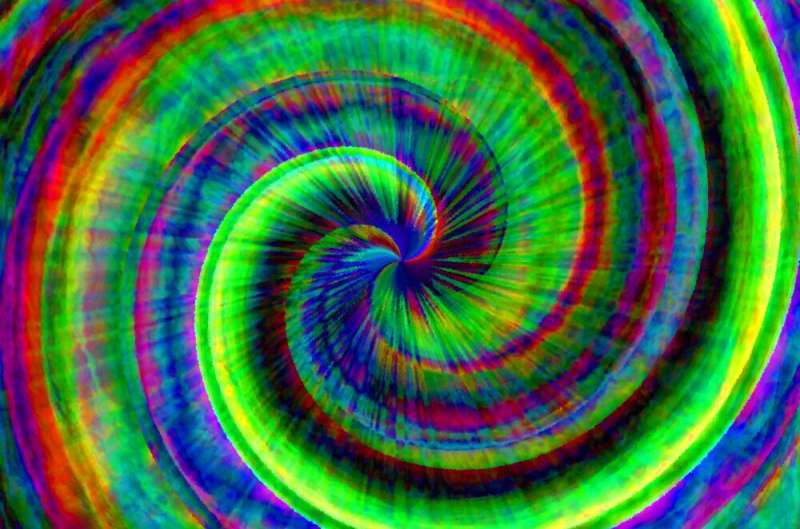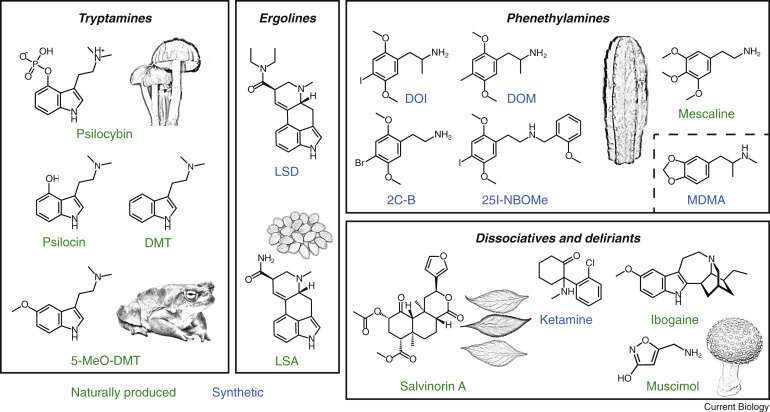The struggle to define psychedelics

Psychoactive drugs include all manner of hallucinogens, deliriants, hypnotics and psychedelics. But what is a psychedelic, really? Insofar as many in the field are now moving toward bringing new molecules with presumably desirable introspective properties into a larger, potentially druggable populace, there is a palpable need for increased clarity.
There is a curious push to define psychedelics as compounds that alter consciousness by acting on serotonin receptors in the brain, most notably 5-HT2A receptors. However, that is a terribly parochial definition that clearly suffers from a narrow perspective—surely, many receptors, and likely many non-receptor effects, can create what is already commonly understood as a psychedelic effect.
A timely attempt to bring further order to the world of psychedelic molecules was recently put forward in the journal Current Biology. The authors offer a divide-and-conquer approach that assigns psychedelics to one of three classes based on their chemical structure: tryptamines, ergolines and phenethylamines. The tryptamines, to which 5Ht (serotonin) belongs, yield familiar molecules including psilocybin, psilocin, DMT and 5-MeO-DMT via the addition of methyl groups to the ethylamine chain, as well as the addition of other critical side groups, to the core fused indole benzene-pyrrole ring system.

The ergolines were initially isolated from the ergot fungus, and can be further processed into more familiar derivatives like LSD. Finally, the phenethylamines are based on a scaffold of a benzene ring with an amino group attached through two-carbon. This group includes 2C-B, mescaline, amphetamine analogs such as DOI and DOM, and derivatives such as 25I-NBOMe. This division is handy, hardly exhaustive. some phenethylamines such as MDMA, act through entirely different mechanisms, while deliriants such as muscimol and scopolamine, and dissociatives such as salvinorin A, ibogaine, nitrous oxide, phencyclidine (PCP), and ketamine have entirely unique structures.
All this, and much more was actually laid out many years ago by the late "godfather of psychedelics," Alexander Shulgin, who, together with his wife, penned two famous books on the topic based on his direct experiences with hundreds of compounds he invented and synthesized. These two still unmatched treatises, PiHKAL and TiHKAL (standing for "Phenethylamines I Have Known And Loved" and "Tryptamines I Have Known And Loved"), methodically lay out the first exhaustive rational drug design approach to designer psychedelics. Each instruction synthesis account is typically accompanied by thorough dosing recommendations, comparative routes of administration, bioassays, method of metabolism, and detailed commentary on the time course of effects.
So what has science been able to offer since Shulgin? There have been at least two contributions to the field: The first is the structural determination of a psychedelic-bound 5-HT2A receptors at near-atomic resolution. These reconstructions have enabled detailed computer simulations to identify thousands of candidate compounds which can be tested to evaluate their kinetic binding properties. The second has been major advances in tracing the signal transduction pathways that are activated by receptor binding. In this case, the established canonical pathway involves the G-protein Gαq, which dissociates from the receptor and from its Gβγ partners and activates other downstream effector proteins upon receptor activation.
But there is also another parallel, G-protein-independent pathway mediated by β-arrestins that has come to be viewed with increasing relevance for these drugs. "Some psychedelics appear to be biased ligands such that they preferentially engage 5-HT2A receptors in conformations that favor β-arrestin signaling over the G-protein pathway. In contrast to 5-HT2A receptors, the 5-HT1A receptors are Gi/o-protein coupled and activate other signaling proteins." These kinds of observations now form the basis of more recent and sometimes dubious efforts to deconvolve desirable antidepressant effects of receptor activation from any of the undesirable hallucinogenic effects.
For example, structural analysis comparing receptor-bound serotonin with similarly non-hallucinogenic ligands like lisuride reveal a bias toward arrestin recruitment. Based on these analyses, researchers were able to design arrestin-biased ligands that displayed antidepressant-like activity in mice without hallucination effects. They note that arrestin recruitment alone is insufficient for antidepressant effects, but the low G-protein signaling of the arrestin-biased ligands appears to allow antidepressant effects without causing hallucination.
No comments:
Post a Comment